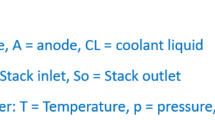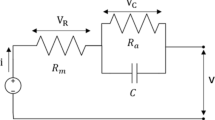Abstract
Operation of a PEM fuel cell stack demands for control of some selected variables in the sake of safety, efficiency and prevention of membrane and electrode damages. Among these variables are the hydrogen pressure, stack temperature, membrane humidity, water concentration and the impurities accumulated on the anode. Several tests were performed to monitor and control these quantities on a 3-kW prototype stack. A few distinct control techniques were implemented in this stack as described in this paper in addition to the main practical operational results at distinct power levels.












Similar content being viewed by others
References
Baik, K. D., & Kim, M. S. (2011). Characterization of nitrogen gas crossover through the membrane in proton-exchange membrane fuel cells. International Journal of Hydrogen Energy, 36, 732–739.
Cheng, S., Fang, C., Xu, L., Li, J., & Ouyang, M. (2015). Model-based temperature regulation of a PEM fuel cell system on a city bus. International Journal of Hydrogen Energy, 40(39), 13566–13575.
Chen, Y., Yang, C., & Lee, J. (2014). Implementation and evaluation for anode purging of a fuel cell based on nitrogen concentration. Applied Energy, 113, 1519–1524.
Farret, F., & Simões, M. (2006). Integration of alternative sources of energy. New Jersey, United States: IEEE Press-Wiley-Interscience.
Fuglevand, W. A., Bayyuk, S. I., Loyd, G. A, Devries, P. D., Lott, D. R., & Scartozzi, J. P. (2002). Fuel cell power system and methods of controlling a fuel cell power system. US Patent 6,387,556 B1, to Avista Labs, May. 14.
Fuglevand, W. A., Devries, P. D., Loyd, G. A., Lott, D. R., & Scartozzi, J. P. (2000). Fuel cell and method for controlling same. US Patent 6,096,449, to Avista Labs, Aug. 1.
Gonzatti, F., Kuhn, V. N., Ferrigolo, F. Z., Miotto, M., & Farret, F. A. (2014). Theoretical and practical analysis of the fuel cell integration of an energy storage plant using hydrogen. In 11th IEEE/IAS international conference on industry applications (INDUSCON), Juiz de Fora–MG.
Gonzatti, F., & Farret, F. A. (2017). Mathematical and experimental basis to model energy storage systems composed of electrolyzer, metal hydrides and fuel cells. Energy Conversion and Management, 132, 241–250.
Gonzatti, F., Nizolli, V., Ferrigolo, F., Farret, F., & de Mello, M. (2016). Experimental hydrogen plant with metal hydrides to store and generate electrical power. International Journal of Emerging Electric Power Systems, 17(1), 59–67.
Hirschenhofer, J. H., Stauffer, D. B., Engleman, R. R., & Klett, M. G. (2005). Fuel cell handbook (6th ed.). London: Pearson Corporation.
Horizon Fuel Cell 3000W Fuel cell stack user manual, 29 p. 2013.
Hou, Y., Shen, C., Yang, Z., & He, Y. (2012). A dynamic voltage model of a fuel cell stack considering the effects of hydrogen purge operation. Renewable Energy, 44, 246–251.
Kim, J., Kim, D., Kim, S., Nam, S. W., & Kim, T. (2014). Humidification of polymer electrolyte membrane fuel cell using short circuit control for unmanned aerial vehicle applications. International Journal of Hydrogen Energy, 39, 7925–7930.
Larminie, J., & Dicks, A. (2003). Fuel cell systems explained. Chichester, West Sussex: Wiley.
Mokmeli, A., & Asghari, S. (2010). An investigation into the effect of anode purgingon the fuel cell performance. International Journal of Hydrogen Energy, 35, 9276–9282.
Nikiforow, K., Karimäki, H., Keränen, T. M., & Ihonen, J. (2013). Optimization study of purge cycle in proton exchange membrane fuel cell system. Journal of Power Sources, 238, 336–344.
Ozen, D. N., Timurkutluk, B., & Altinisik, K. (2016). Effects of operation temperature and reactant gas humidity levels on performance of PEM fuel cells. Renewable and Sustainable Energy, 59, 1298–1306.
Pei, P., & Chen, H. (2014). Main factors affecting the lifetime of proton exchange membrane fuel cells in vehicle applications: A review. Applied Energy, 125, 60–75.
Rabbani, A., & Rokn, M. (2013). Effect of nitrogen crossover on purging strategy in PEM fuel cell systems. Applied Energy, 111, 1061–1070.
Riascos, L.A.M., & Pereira, D. D. (2009). Optimal temperature control in PEM fuel cells. In Industrial electronics IECON’09, 35th annual conference of IEEE, November 2009, Porto, Portugal, pp. 2778.
Riascos, L. A. M., Simões, M. G., Cozman, F. G., & Miyagi, P. E. (2006). Bayesian network supervision on fault tolerant fuel cells. In 41st IAS annual meeting, Octuber 2006, Tampa, Florida, vol. 2, pp. 1059–1066.
Saygili, Y., Eroglu, I., & Kincal, S. (2015). Model based temperature controller development for water cooled PEM fuel cell systems. International Journal of Hydrogen Energy, 40(1), 615–622.
Simões, M. G., & Shaw, I. S. (2007). Fuzzy control and modeling (Controle e Modelagem Fuzzy), Ed. Blucher, 2th ed, São Paulo-SP, Brazil.
Strahl, S., Husar, A., & Riera, J. (2014). Experimental study of hydrogen purge effects on performance and efficiency of an open-cathode Proton Exchange Membrane fuel cell system. Journal of Power Sources, 248, 474–482.
Yu, X., Pingwen, M., Ming, H., Baolian, Y., & Shao, Z. (2009). The critical pressure drop for the purge process in the anode of a fuel cell. Journal of Power Sources, 188, 163–169.
Zhan, Y., Guo, Y., Zhu, J., & Li, L. (2014). Current short circuit implementation for performance improvement and lifetime extension of proton exchange membrane fuel cell. Journal of Power Sources, 270, 183–192.
Acknowledgements
The authors are very grateful to CEEE-GT and CEESP/UFSM for the infrastructure support and financial conditions to develop this work.
Author information
Authors and Affiliations
Corresponding author
Rights and permissions
About this article
Cite this article
Gonzatti, F., Miotto, M. & Farret, F.A. Proposal for Automation and Control of a PEM Fuel Cell Stack. J Control Autom Electr Syst 28, 493–501 (2017). https://doi.org/10.1007/s40313-017-0322-2
Received:
Revised:
Accepted:
Published:
Issue Date:
DOI: https://doi.org/10.1007/s40313-017-0322-2




